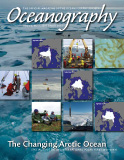Article Abstract
For the last 20 years, civilian researchers have used the Sound Surveillance System (SOSUS), a US Navy hydrophone array deployed for anti-submarine warfare during the Cold War, to detect seismic and volcanic activity in the Northeast Pacific Ocean. A total of 46,498 earthquakes have been located along oceanic plate boundaries, providing a comprehensive view of volcano-tectonic activity in the region. During the 20-year interval, the Northeast Pacific spreading centers exhibited both high levels of continued background seismicity (Explorer and Gorda segments) and long periods of quiescence punctuated by brief periods (days to weeks) of intense (> 1000 events/day) earthquake activity. The Juan de Fuca Ridge south of the Cobb Offset is largely aseismic, with the exception of events associated with two three-week-long volcanic eruptions and frequent seismicity at 46°50’N. In contrast, the Endeavour, Explorer, and Gorda Ridges, and the Cobb Offset are highly seismic, producing continuous earthquake activity. Of the seven major episodes of seafloor spreading identified by analysis of the SOSUS data, three resulted in lava eruptions onto the seafloor and release of large hydrothermal plumes. The Blanco Transform produces the most earthquakes and the largest seismic energy release of any Northeast Pacific plate boundary. The Explorer and Gorda plates are also very seismically active, which is consistent with these areas being highly fractured deformation zones that are structurally independent from the Juan de Fuca plate.

